Redness in the cheeks, nose, forehead, chin, rashes in the form of pustules or bumps - this is how rosacea, a very common skin disease, manifests itself. The main treatment for rosacea – exclusion of disease-causing factors plus drugs. The disease is chronic and completely curable, alas, is not amenable to – may "bloom" again on the face a week, a month and even years after the therapy. Therefore, you should always have at hand a couple of proven home remedies for dealing with the disease, which estet-portal.com will tell about.
Types and symptoms of rosacea
Rosacea is often confused with acne or with allergic reactions. But unlike acne, rosacea does not affect teenagers, but people in their 30s and 50s. Scientists have not yet determined the cause of the disease. There is an assumption that the roots should be sought in genetics, malfunctions of the immune system, in the "intrigues" bacterial infection or microscopic mite. Be that as it may, but this disease, which loves mainly fair-skinned women, must be treated as early as possible, because over time the condition of the skin may worsen.
In addition to the areas of the face already mentioned, rosacea can "occupy" ears, chest, back. 4 types of disease are diagnosed:
- erythemotelangiectasia rosacea: on the skin, in addition to redness, sometimes a vascular network is visible;
- papulopustular rosacea: redness and swelling "enriched" inflammatory papules;
- Fimar rosacea makes the skin thick and bumpy;
- ocular rosacea affects the eyes and eyelids – they become inflamed, red, dry.
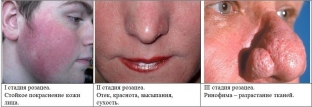
The symptoms of rosacea are:
- dry, rough skin;
- pronounced redness, especially in the center of the face;
- appearance of a vascular network;
- burning, itching of affected areas;
- skin sensitivity and swelling;
- appearance of pimples, papules, pustules (erythemotelangiectasia rosacea);
- thickening of the skin, enlargement of the nose and surrounding tissues (fimar rosacea);
- eyes watery, bloodshot, burning, eye irritation, photosensitivity (ocular rosacea).
If you experience these symptoms, see a dermatologist. Only a specialist can confirm the diagnosis, prescribe medication, which you can easily support with home remedies, which should be reported to the doctor.
The risk group is fair-skinned people aged 30-50 years. Often these are those who blush easily and have relatives suffering from this disease. Rosacea affects women more often.
Rosacea treatment at home
There are 3 important stages in the non-drug fight against the manifestations of rosacea:
- cleansing and skin care;
- use of herbal non-drugs;
- healthy lifestyle and diet.
First step in rosacea treatment: cleansing and moisturizing
Proper cleansing of the skin is far from the last place in the difficult process of treating rosacea. Since excessively secreted sebum clogs the pores, irritating the epidermis and provoking the development of the disease, it is very important to remove it in time and thoroughly.
It is better to do this with oil: one fatty substance perfectly dissolves another. But be careful: for cleansing rosacea-prone skin, it is important to choose non-comedogenic oils. They do not clog pores, thus eliminating the appearance of new acne. Be sure to test the oil on a small area first. If after a day you come to the conclusion that the result suits you, use it for daily cleansing. To wash with oil, you need to take a small amount of it in the palm of your hand and lightly massage your face in circular motions for 2 minutes. If you wish, you can use ½ cup base oil add 1-2 drops of essential oil, for example, lavender, which has anti-inflammatory and antiseptic effects. For better absorption of the oil put a cotton napkin soaked in warm water on your face for 20 seconds. It can also remove the remaining oil. If necessary, repeat the procedure again, soaking the cloth in warm water and gently rubbing the skin with it until the oil is completely removed. Pat your face gently with a soft towel. In no case do not rub the skin, otherwise a new irritation cannot be avoided.

All kinds of "steam baths" are excluded; for the face, as well as chemical and mechanical peelings. In case of emergency, you can use an enzyme peel designed for skin with a vascular network.
After cleansing, moisturize the skin with cream. But in the process of treating rosacea, many are faced with the so-called cosmetic intolerance syndrome. Especially if they contain active substances. Definitely worth abandoning products with preservatives, lanolin, propylene glycol, eucerin and ethyl alcohol. How then to moisturize the skin? Best oil based cream. It can also be creams with green tea extract, with niacinamide (a type of vitamin B that relieves irritation and moisturizes well), with Chrysanthellum Indicum extract – golden chamomile (helps strengthen blood vessels and reduce redness), with azelaic acid (has antibacterial properties, reduces redness and rashes).
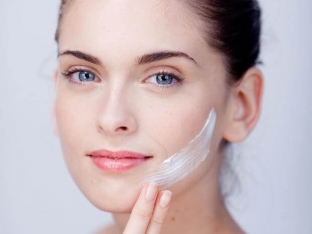
Be sure to use a sunscreen with a filter of at least 15 when you go out. If conventional sunscreens cause irritation, opt for products with physical filters that reflect UV rays. You can use a natural sunscreen with retinol, beta-carotene or vitamin E.
High temperature complicates the treatment of rosacea. On hot days, it is worth cooling your face by putting a napkin soaked in cool water on it.
The most effective non-drug treatments for rosacea
Chamomile holds the palm in the treatment of rosacea due to its anti-inflammatory properties. Chamomile-based products relieve inflammation, reduce redness, soothe the skin.
Pour 3-6 tea bags of chamomile with 3 cups of boiling water, leave for 10 minutes, strain. Let cool to room temperature and put in the refrigerator for a couple of minutes. Apply a cotton napkin soaked in a cool infusion to the face for 15 minutes. Repeat the procedure 3-4 times a day until the condition improves. To rule out an allergic reaction, test the lotion on a small area.
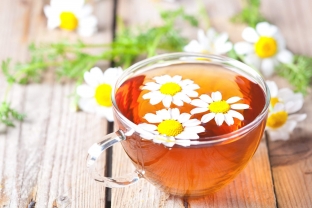
Green tea fights free radicals and has anti-cancer and anti-inflammatory properties. As it turned out, the combination of these properties is effective in the treatment of rosacea. Green tea reduces the excessive sensitivity of the skin to UV light, which in turn prevents the appearance of rashes and acne as a reaction to the sun's rays.
2 cups of brewed green tea chill for half an hour in the refrigerator. Apply a cloth soaked in tea for a few minutes to problem areas. This will relieve inflammation and reduce redness. Repeat the procedure twice a day for several months. In addition, it is worth "taking inside" - Drink 2 cups of green tea a day. This will moisturize the skin from the inside, saturate the body with antioxidants, which will help treat rosacea.
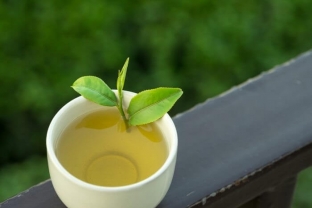
Oatmeal is anti-inflammatory and a good source of antioxidants. Helps relieve redness, itching, reduce inflammation.
Mix half a cup of crushed cereal with a quarter cup of water. Apply the gruel on the face and smooth it slightly, but in no case rub it into the skin so as not to cause additional irritation. After 20 minutes, rinse with cold water, gently pat dry with a soft towel. Repeat the procedure twice a day for several days.
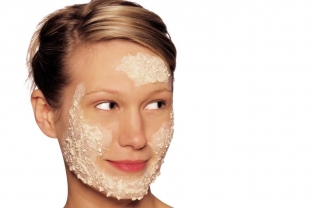
Licorice (licorice, licorice) helps to get rid of redness – first sign of rosacea. Licorice extract has a strong anti-inflammatory, vascular-strengthening effect and promotes the renewal of skin cells, restoring its healthy appearance.
Mix 1 tbsp. spoon of licorice powder, 1 teaspoon of honey, 1 teaspoon of aloe juice. Apply the mixture on the face, rinse with warm water after 15 minutes. Make a mask twice a day for one and a half to two months.
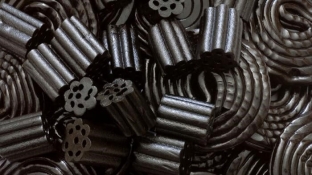
Lavender oil has antiseptic and anti-inflammatory properties. They can be applied to the affected areas of the skin twice a day for several weeks.
Add 1 drop of lavender oil to 1 tbsp. a spoonful of almond Before going to bed, gently apply the mixture to problem areas, rinse with warm water in the morning. The procedure is carried out over several weeks. Since lavender oil can cause allergies, be sure to test it on a small area before treating rosacea.
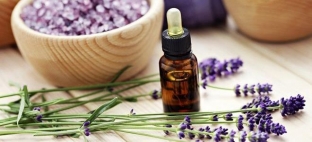
Honey has antibacterial, anti-inflammatory properties. In addition, it perfectly moisturizes the skin without making it oily.
Mix 2 tbsp. spoons of natural honey, 1 tbsp. a spoonful of olive oil, one and a half teaspoons of whole milk. Apply the resulting mixture on the face, rinse with water after 10 minutes. Repeat 1-3 times a week. But honey cannot be used if there is a vascular network on the skin.
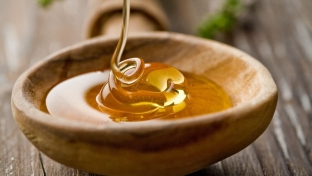
Apple cider vinegar boasts not only anti-inflammatory properties, but also the ability to maintain proper cell pH. In addition, it is an excellent disinfectant that effectively destroys fungi and bacteria from the epidermis.
In a glass of filtered water, stir 1 teaspoon of apple cider vinegar and 1 tbsp. a spoonful of honey Take a drink twice a day – morning and evening for 6-8 weeks.
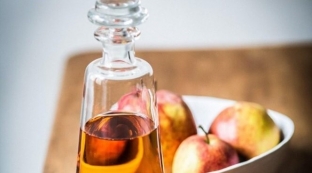
Aloe is used to treat rosacea, as the substances present in this plant promote skin regeneration processes, as well as relieve redness and irritation.
Lubricate the skin with aloe juice, after drying, rinse with warm water.
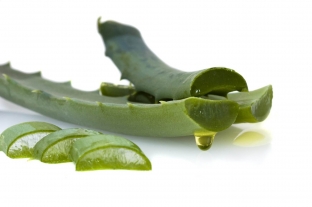
Turmeric has powerful antibacterial, antiseptic and healing properties. Its regular use (both externally and internally) helps fight redness and inflammation of the skin.
A mask of 1 teaspoon of turmeric and 1 tbsp. Spoons of natural yogurt apply for 20 minutes, then rinse with warm water. Do it daily until the symptoms of the disease begin to disappear. Stir 1 teaspoon of turmeric in a glass of water or milk. Drink "elixir" twice a day until the condition of the epidermis improves. But be prepared for the fact that turmeric can stain the skin.
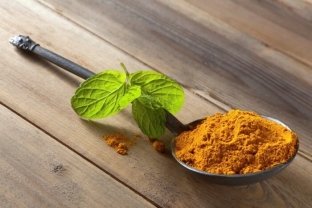
Flax seed – a source of unsaturated fatty acids that have a beneficial effect on the skin, helping to cope with excessive redness and inflammation.
It is recommended to drink 1 teaspoon of flax seed oil 3 times a day for two months, and after successful treatment of rosacea, add flax seed to your menu to prevent the recurrence of the disease.
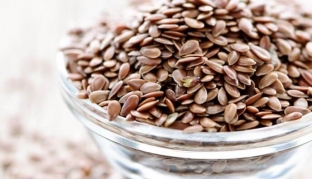
The role of nutrition in the treatment of rosacea
The main emphasis in nutrition should be on foods with anti-inflammatory properties:
- fruits and fresh vegetables (unsweetened apples, pomegranate, melon, spinach, cabbage, broccoli, beets, carrots, potatoes, cucumbers, pumpkin);
- greens, garlic;
- berries (blackberries, strawberries, blueberries, raspberries, gooseberries);
- whole grains;
- legumes;
- nuts, seeds;
- foods containing omega-3s, e.g. salmon, mackerel;
- wheat germ, brown rice;
- chicken eggs;
- mushrooms: champignons, chanterelles, boletus.
Half of the diet during the treatment of rosacea should be vegetables and fruits. But at the same time, citrus fruits, grapes and other sweet fruits should be excluded, as they cause inflammation on the skin.
It is worth paying attention to nutritional supplements:
- vitamin C (strengthens blood vessels);
- riboflavin (promotes the growth of new skin cells);
- pancreatin (helps reduce inflammation);
- zinc (60-75mg daily, up to 3 months).
Forbidden:
- red meat;
- prepared foodstuffs;
- anything that contains preservatives and additives, sugar and sweetener;
- hot drinks;
- alcohol;
- tea, coffee, cola;
- spicy food.
What can trigger rosacea
For rosacea treatment to be successful, it is important to avoid factors that can trigger a relapse even after the symptoms disappear. These include:
- sunshine, wind;
- stress, emotional outburst;
- high temperature;
- physical strain;
- alcohol, spicy food;
- hot bath;
- skin irritating cosmetics;
- sunbeds and pools with chlorinated water;
- lack of sleep.






Add a comment